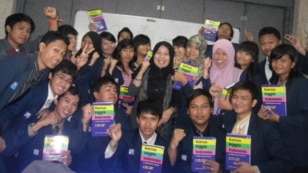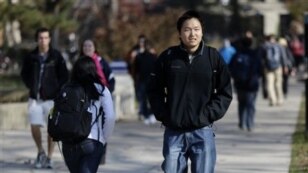America continues to lead the world as a destination for international students. Last year about 900,000 foreign students were studying in the United States, about half of them from Asia. But a growing number of Asian students are looking to an English-speaking country much closer to home—the Philippines.
The island nation of 100 million is quickly becoming the education center of Asia. The country’s low prices, open culture, and quality schools are attracting record numbers of foreign students. Koreans are leading the way, according to Jose L. Cuisia, the Philippines Ambassador to the United States.
“There are more and more Koreans that are studying English in the Philippines. In 2004, there were about 5,700.... The following year, it tripled to about 17,000, in 2012 it was about 24,000. So we’re seeing an increasing number of Koreans. But they’re also from other countries: Libya, Brazil, Russia.”
The Philippines is in a unique position to benefit from the global demand for English education. American colonialism brought the English language here in the early twentieth century. Although it is not the native language of most Filipinos, English is an official language here. More than 60 years after independence, Filipinos still speak English with a strong American accent. Today, the Philippines markets itself as the world’s third-largest English-speaking country.
“The truth is we actually have more people who speak English in the Philippines than the national language…English is learned even outside of school because a lot of the communications done in English, public signs are in English, television, Internet’s all in English.”
Low prices and its location in Asia helped to produce the education explosion in the Philippines. The capital, Manila, has cheap non-stop flights to Tokyo, Seoul, and other Asian capitals. The rising U.S. dollar has made American education more expensive than ever before.
There are hundreds of private and public schools in the Philippines that teach English or teach in English. More advanced students can take regular university academic courses in English. Others study at beachside resorts, where they mix language study with vacation. Some Korean families even move to the Philippines so their children can learn English in public schools.
As in the U.S., schools in the Philippines range from world-class to low-quality “diploma mills.”
Pearl Gaborno-Ilustre is the Chief Academic Officer at the TESOL Training Corporation in Manila. She says foreign students should choose their schools carefully. She recommends programs that use a modern teaching style.
“One doesn’t really learn language by studying grammar; we learn language by actually using it... And the Philippines is moving toward an outcomes-based education, which means that skills taught in the classroom, or concepts taught in the classroom should have concrete goals or outcomes, outputs from the students.”
In most Asian countries, students learn English through grammar and translation from the mother language. In the Philippines, students are encouraged to practice speaking English in real-life situations. In general, there is less emphasis on grammar and error correction.
“In the Philippines you can see English everywhere, on the signs, in businesses and offices, in schools. So that somehow makes us teach English with a future in mind.”
Can the Philippines offer the same quality of education as the United States? Ms. Gaborno-Ilustre says that is a difficult question.
“Academically, we can teach English well, but in terms of usage it’s still different when a native speaker is the one teaching. But we’re not far behind.”
Shota Furue is a Japanese student who has studied English in the U.S. and the Philippines. He says the U.S. is better for advanced learners. But he recommends the Philippines for beginners.
“They speak English as a second language...when they’re a child they learn English and they know the difficulty of speaking English… For beginners it’s better to study in the Philippines.”
Visitors may come here for the low costs and white sand beaches, but they stay for the people. Almost anyone can feel at home in the Philippines, with its unique blend of Asian, Spanish, and American cultures.
Tatiana Sergeeva is a Russian living in the Philippines. She manages the Genius English Proficiency Academy in the city Lapu Lapu. About 20 percent of the students at her school are Russian.
“[In the] Philippines you have very good weather and also very good people around. Russian people you know they’re strict people, not so smiling people, you know. But Filipino people always smile, always happy…. And what I observe, Russian students [are] very change[d].”
Ambassador Cuisia agrees that Filipino people are part of the attraction.
“That is part of the nature of the Philippines—very hospitable, very welcoming, and that to me is our biggest asset for a tourism industry... When it comes to welcoming people, the Filipinos are unmatched.”
I’m Christopher Jones-Cruise.
Adam Brock reported and wrote this story for Learning English. Jill Robbins was the editor.
Words in This Story
unique – adj. used to say that something or someone is unlike anything or anyone else
colonialism - n. control by one country over another area and its people
diploma mill - n. an institution or organization that grants large numbers of educational degrees based on inadequate or inferior education and assessment of the recipients
TESOL – abbreviation. Teachers of English to Speakers of Other Language
outcome – n. something that happens as a result of an activity or process
translation – n. the act or process of translating something into a different language
emphasis – n. special importance or attention given to something
Now it’s your turn. Where would you like to go to study English? Write to us in the comments section.

